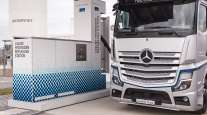Fuel Efficiency Is the Main Goal in Trailer Aerodynamics

[Stay on top of transportation news: Get TTNews in your inbox.]
When trailer aerodynamics produce better fuel efficiency, the reward for truck fleets can be substantial, and success is measured by miles per gallon. Improving performance from 6 mpg to 10 mpg, for instance, could reduces fuel costs by 10% in some cases.
Improving the aerodynamics of a trailer, as a way to improve fuel efficiency, typically relies on the installation of products such as skirts, fairings and mudflaps — items that can be factory-installed but are often acquired on the aftermarket.
Fleet managers who see the value of such products have sometimes encountered challenges. The products may work if properly deployed but if they depend on regular deployment actions by drivers, the investment could go for naught. Even more troubling, the products could add weight to the trailers or require too much upkeep to maintain the desired return on investment.
Manufacturers have sought to strike the right balance between firmness and flexibility in products such as skirts and flaps to deliver on fuel savings with minimal operational issues. Providers have focused in recent years on improving not only the quality and reliability of aerodynamic products for trailers, but also the testing process so as to offer confidence the products will provide the desired results.
Daryl Bear, lead engineer and chief operating officer at London, Ontario-based Mesilla Valley Transportation Solutions, said the company looks at multiple issues when testing aerodynamics products for truck fleets.
“We’re measuring what the savings are and seeing if there’s even potential there,” he said. “We use two trucks and we have it mounted with sensors, fuel flow meters and aerodynamic sensors. Then we have an energy method that removes a lot of variables, so you get more accurate test results.”
Bear added that most of the test is on the track for add-on products, as well as the highway to compare power units. MVT Solutions also tests product operation performance and provides information to vendors to help with the product’s continuous improvement.

According to David Giesen, vice president of sales at Stoughton, Wis.-based Stoughton Trailers, fuel skirts are the product most seen as making progress in their performance and acceptance by the industry.
“Fuel skirts continue to grow each year in the share of what we build,” Giesen said, “because the fuel skirts have a real return on investment from a fuel-saving standpoint, and they’re very easy to put on. They don’t involve driver interaction.”
Stoughton Trailers sources out the production of skirts to two manufacturers: Ridge Corp. and TransTex. The key, Giesen noted, is finding skirts that are well designed and made from materials that can take some abuse.“When you back these trailers into docks that have a mound, or into a railroad track, the skirts will sometimes hit those obstacles,” Geisel said. “You need a skirt that can bounce back.”
Todd McGuire, vice president of sales and marketing for Indianapolis-based Transtex, said the company underwent a redesign and re-engineering process in 2016 because OEMs wanted skirts that would offer more flexibility and resilience.
The key to achieving that objective, McGuire said, was the bracket, which has to be durable in both hot and cold climates. Transtex found that an engineered nylon resin served as the soft material that would ensure the skirts would bend if the vehicle made contact with a dock, a curb or a snowbank.
“Your skirt is not going to be damaged if the bracket allows the skirt to move,” he explained. “So a bracket is the critical piece that holds it to the trailer. You obviously want the skirt to be straight for aerodynamics and maximum fuel savings.” Since the redesign, McGuire said, Transtex has manufactured 5 million skirts without a warranty claim or damage return.
MVTS' Bear said the use of outside suppliers is consistent with where the industry is going. “What we’re seeing with trailer manufacturers now, compared to when they started in aerodynamics, is they’re much more open to outside aerodynamic solutions,” he said.
The North American Council for Freight Efficiency recently produced a report setting priorities for the industry when sourcing aerodynamics products. Among the report’s recommendations are for fleets to carefully consider the interplay of aerodynamic devices with their “specific duty cycles,” especially concerning accessibility for maintenance and repair.
According to Rick Mihelic, director of emerging technologies for NACFE, fleet options are limited by the nature and design of the trailers they are operating.
“There’s not really much else you can do to a standard box because there are so many permutations and manufacturers out there,” he said. “You can start out with things that are visually smart to do, like wheel covers and aerodynamic mudflaps. Those things are visually obvious improvements.”
Mihelic credits the U.S. Department of Energy’s multiphase SuperTruck program for helping to elevate the aerodynamic performances of both tractors and trailers.
The SuperTruck programs were launched by the U.S. Department of Energy in an attempt to improve the efficiency of heavy trucks. SuperTruck 1 was launched in 2009, with Daimler Truck, Volvo Trucks, Navistar and a joint effort between Cummins and Peterbilt comprising the four teams that worked on various priorities – including improved aerodynamics.

Transtex's T-Flex Blue Bracket is angled to withstand stronger loads. (Transtex)
The second phase of the program launched in 2017.
“Ten years ago, you were seeing maybe 6-7 miles per gallon out of the products,” Mihelic said. “A really well-driven one might be 7.6 miles per gallon. The SuperTruck 1 and SuperTruck 2 programs are heavily focused on aerodynamics.”
As a result, tractor-trailers can achieve 8.5 mpg doing local hauls, and 10 mpg doing longhaul routes. “You can get a really good product driven poorly and get bad fuel economy. The driver can be a third of the fuel economy,” Mihelic said.
Innovators are working to bring new products to the industry, but they often run into manufacturer reluctance.
Olympia, Wash.-based Aerovolution is testing a product called Booster-Tail with MVTS. According to the company’s website, the product automatically opens when a vehicle reaches 60 miles per hour and doesn’t require driver action or additional hardware. Lee Telnack, the company’s founder and CEO, said he hopes to make the case that the tails will be both reliable and low maintenance.
“Applying that to land yachts, so to speak, we knew what the geometries were,” he said. “It’s just a matter of simplifying the mechanisms for the most difficult part of the trailer to access. So we developed a universal attachment system that can ride over the hardware of any OEM’s or fleet’s specs for hardware.”
Bear acknowledged that new technologies face challenges in terms of fleet adoption.
“The bottleneck at this point, especially at the rear of the trailer, is getting fleets to adopt them,” Bear said. “We do the testing and share the information and encourage the fleets to adopt them.”
For fleets who are reluctant to move forward with aerodynamics, Bear encouraged them to talk to other fleets who have done well with the products that improve fuel efficiency.
“What we always tell people is your truck’s going down the road anyway,” he said. “So, if you can improve the fuel economy of it by adding products that don’t interrupt operations, why wouldn’t you?
Want more news? Listen to today's daily briefing below or go here for more info:




